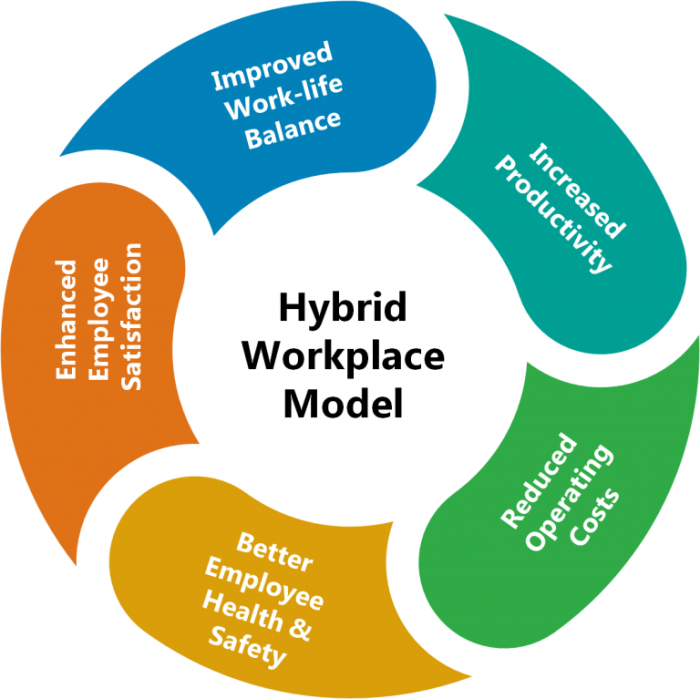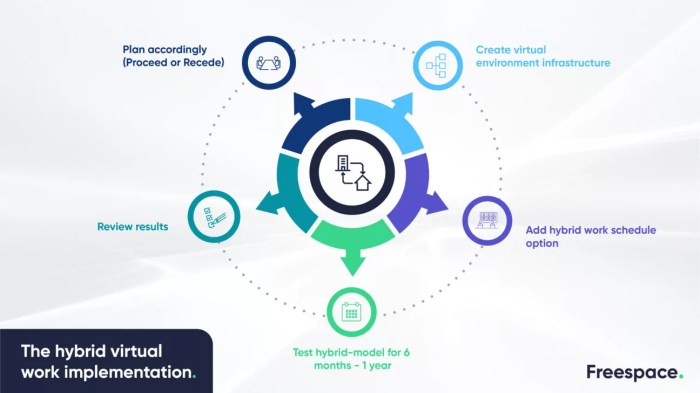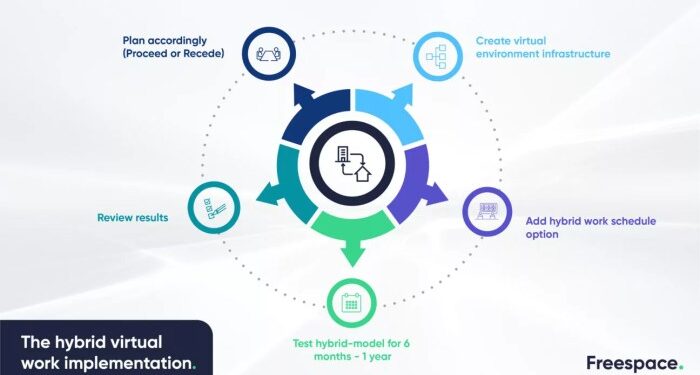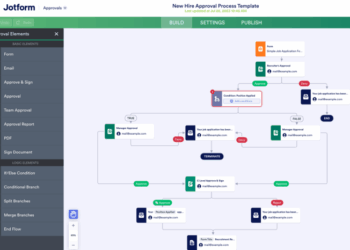Exploring the realm of Effective Resource Management Strategies in Hybrid Work, this introduction sets the stage for a dynamic discussion on enhancing productivity and collaboration in modern work environments.
As we delve deeper, we will uncover the key components and strategies that play a vital role in navigating the challenges and reaping the benefits of a hybrid work model.
Understanding Hybrid Work Environment

Hybrid work refers to a work setup where employees have the flexibility to work both remotely and in the office. This model has gained significant importance in modern workplaces due to its ability to combine the benefits of remote work with the collaboration opportunities offered by in-person office settings.
Implementing a hybrid work model comes with its own set of challenges and benefits. On one hand, it can improve work-life balance, increase employee satisfaction, and reduce commuting time and costs. On the other hand, it can lead to communication barriers, feelings of isolation among remote workers, and difficulties in maintaining team cohesion.
Effective resource management plays a crucial role in optimizing hybrid work environments. It involves efficiently allocating resources such as technology, workspace, and time to ensure that employees can work productively regardless of their location. By implementing strategies to manage resources effectively, organizations can overcome the challenges associated with hybrid work and create a conducive environment for both remote and in-office employees.
Resource Allocation in Hybrid Work

In a hybrid work setup, effective resource allocation is crucial to ensure productivity and efficiency. This involves managing various types of resources to support remote and in-person work seamlessly.
Types of Resources in Hybrid Work
- Human Resources: Managing and allocating team members effectively based on their skills and availability.
- Technological Resources: Ensuring employees have access to the necessary tools and technologies to collaborate and work efficiently.
- Physical Resources: Allocating office space, equipment, and supplies for both in-person and remote work.
- Time Resources: Balancing work schedules and deadlines to optimize productivity.
Tools and Technologies for Resource Allocation
- Project Management Software: Tools like Trello, Asana, or Jira help in assigning tasks, tracking progress, and managing resources effectively.
- Communication Platforms: Platforms like Slack, Microsoft Teams, or Zoom facilitate seamless communication and collaboration among team members.
- Cloud Storage Solutions: Services like Google Drive, Dropbox, or OneDrive allow for easy access and sharing of documents and files from anywhere.
Prioritizing Resource Allocation for Productivity
- Identify Key Priorities: Determine which resources are critical for achieving business goals and focus on allocating them accordingly.
- Regular Communication: Keep open communication channels to understand the needs and challenges of team members to allocate resources effectively.
- Flexibility: Be adaptable in reallocating resources based on changing work dynamics or priorities to maintain productivity levels.
Communication Strategies for Hybrid Work
Effective communication is crucial in a hybrid work environment where employees are split between remote and in-office settings. Clear and seamless communication channels are essential to ensure that all team members stay connected and informed. Here are some strategies to help maintain effective communication in a hybrid work setup:
Utilize Multiple Communication Platforms
Incorporate various communication tools such as email, instant messaging, video conferencing, and project management software to cater to different communication needs. This ensures that employees can choose the most suitable platform for each type of communication, whether it's a quick update or a detailed discussion.
Establish Regular Check-ins
Schedule regular check-in meetings to keep everyone on the same page. These meetings can be daily stand-ups, weekly team updates, or monthly progress reviews. Regular communication helps prevent misunderstandings and ensures that everyone is aligned with team goals and objectives.
Clarify Expectations and Guidelines
Clearly define communication expectations and guidelines for both remote and in-office employees. Provide a framework for how and when communication should take place, including response times for emails and messages. Setting clear expectations helps avoid confusion and ensures that everyone knows how to communicate effectively.
Encourage Open Communication
Create a culture of open communication where employees feel comfortable sharing their thoughts, ideas, and concerns. Encourage feedback and suggestions from all team members, regardless of their location. Open communication fosters collaboration and innovation within hybrid teams.
Facilitate Team Building Activities
Organize virtual team building activities to strengthen relationships and foster a sense of unity among remote and in-office employees. Activities like virtual happy hours, online games, or collaborative projects help team members connect on a personal level and build trust with one another.
Employee Engagement and Collaboration
Employee engagement plays a crucial role in the success of a hybrid work environment. It is essential to implement strategies that ensure remote and in-office employees feel connected and motivated to contribute effectively to the organization. Collaboration tools also play a significant role in fostering teamwork and communication among team members, regardless of their physical location.
Strategies to Enhance Employee Engagement
- Implement regular check-ins and virtual team meetings to keep employees connected and informed about ongoing projects.
- Encourage open communication channels for employees to share ideas, feedback, and concerns.
- Organize virtual team-building activities and social events to strengthen relationships and boost morale.
- Recognize and reward employees for their achievements and contributions, both individually and as a team.
Role of Collaboration Tools in Promoting Teamwork
Collaboration tools such as Slack, Microsoft Teams, and Zoom have become essential in facilitating communication and collaboration among remote and in-office employees. These tools allow team members to share files, communicate in real-time, and collaborate on projects seamlessly, regardless of their physical location.
Examples of Successful Collaboration Initiatives
- Virtual brainstorming sessions using collaborative whiteboard tools to generate ideas and solutions collectively.
- Project management platforms like Trello or Asana to assign tasks, track progress, and ensure transparency within the team.
- Virtual coffee breaks or casual chat rooms to encourage informal interactions and build relationships beyond work tasks.
- Regular team challenges or contests to promote friendly competition and teamwork among employees.
Flexibility and Adaptability
Flexibility and adaptability are crucial aspects of effective resource management in a hybrid work environment. As work dynamics continue to evolve, organizations need to be able to adjust their resource allocation strategies to meet changing needs and priorities. By fostering a culture of adaptability, businesses can optimize resource utilization and ensure that employees have the tools and support they need to succeed in a hybrid work model.
Creating Flexible Resource Allocation Strategies
One way to create flexible resource allocation strategies is to regularly assess the needs of different teams and departments within the organization. By staying informed about changing workloads, project priorities, and employee preferences, managers can make informed decisions about how to allocate resources effectively.
It's also important to have clear communication channels in place so that adjustments can be made quickly and efficiently as needed.
- Implement a system for tracking resource utilization and availability in real-time.
- Encourage cross-training and skill development to ensure that employees can adapt to changing roles and responsibilities.
- Consider implementing a flexible work schedule to accommodate different working styles and preferences.
Fostering a Culture of Adaptability
Building a culture of adaptability starts with leadership setting the tone and leading by example. Managers should encourage open communication, feedback, and collaboration among team members to foster a culture of continuous learning and improvement. By empowering employees to take ownership of their work and make decisions autonomously, organizations can create a more agile and responsive workforce.
- Encourage experimentation and innovation by giving employees the freedom to try new approaches and solutions.
- Provide training and development opportunities to help employees build new skills and adapt to changing work environments.
- Celebrate and reward adaptability and flexibility in the workplace to reinforce these values and behaviors.
Ultimate Conclusion
In conclusion, the journey through Effective Resource Management Strategies in Hybrid Work unveils the importance of adaptability, communication, and engagement in fostering a successful hybrid work environment.
Questions and Answers
How can effective resource management improve productivity in a hybrid work setup?
By strategically allocating resources, teams can streamline workflows and ensure that all members have access to the tools they need, ultimately boosting productivity.
What are some common challenges faced when implementing a hybrid work model?
Challenges may include maintaining effective communication, balancing in-office and remote work dynamics, and ensuring equal opportunities for all team members.
Why is flexibility important in resource allocation for hybrid work environments?
Flexibility allows teams to adapt to changing work dynamics, allocate resources based on current needs, and optimize efficiency in a dynamic work setting.













